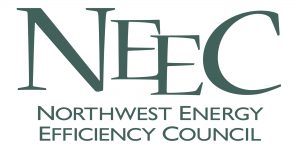NEEC was busy during 2016 and here are some highlights of what we accomplished.
- Meter based savings (pay for performance) became a program reality. Our advocacy for this approach started in 2012, a bit of a lonely journey for us at the start. In 2016, the validity and merits of a meter based approach have been demonstrated through successful pilots by Seattle City Light and the Energy Trust of Oregon. The topic is now on almost every energy conference agenda. The approach has a bright future. More energy efficiency will happen because of it.
- Energy benchmarking and public transparency blossoms in Seattle and Portland. NEEC began its advocacy for energy disclosure requirements in 2008. Persistent advocacy for this idea by NEEC has helped bring benchmarking requirements to both Seattle and Portland. This year Portland became the 2nd city in the region to enact a law and did so with provisions for full public disclosure of building EUIs. Seattle took the step in 2016 to enhance their existing ordinance with new full public disclosure features. In 2017, energy efficiency businesses will see customer energy use intensities. How does that enhance your capabilities for a productive first customer meeting!
- Smart Buildings Center turns one year old. The SBC finished its first full year of operation and things went great. Our Training and Event Space as well as our Conference Board Room were offered free of charge to all who share our passion about the built environment. Wow, free works. We hosted more than 200 meetings and events attended by over 3,700 people. While visiting us, folks could browse our information about smart and efficient technologies or play with the Smart Board and its display of real time energy and performance data from the newly renovated Pacific Tower. The SBC Tool Lending Library is lending, for free, a wide variety of diagnostic tools. Who’s using them – all kinds of folks, ranging from energy service providers, commissioning agents, utility personnel and facility folks. End uses are all over the map from multi-family buildings, to large industrial, to all stripes of commercial and institutional occupancies. Big news for 2017 – with support from the Energy Trust of Oregon, the library will be available to borrowers throughout the Trust’s Oregon service territory.
- Power Hours in Seattle and Portland. They are after work. NEEC buys the beer, wine, and munchies. If you aren’t coming to these (and telling everyone in your organization about them) then you need to start. Great way to network. We had special guests throughout the year from utilities, NEEA, local governments, and more.
- NEEC co-sponsored a bunch of events. To name a few, the West Coast Energy Management Congress, the Energy Future Conference (SEA and PDX), BOMA Engineers Skill Hour, and the PNNL Connected Building Challenge. We provided member discounts and lined up lots of presentation opportunities for members.
- Building Tune Ups coming to Seattle. This has been on NEEC’s advocacy list for quite a while now. We worked closely with Seattle’s Office of Sustainability & Environment to help get this mandate for all commercial buildings over 50,000 square feet through the Seattle City Council. Every five years, more than 600 buildings across Seattle will be engaging energy service providers to complete an operational tune up of their building. Builds customer relationships doesn’t it. I’d expect capital measures to follow.
- Washington State Energy Code training. This year marked the first year of implementation for the 2015 WSEC and NEEC developed and delivered, with funding support from NEEA, multiple trainings across the state on the non-residential portion of the code. Nearly 1,000 design and construction professionals and local jurisdictions took advantage of these free trainings. NEEC also developed a new suite of Excel based compliance forms to facilitate code compliance (free downloads the website).
- Articulated industry concerns about Momentum Savings. A substantial body of analysis produced from BPA’s planning group identified a set of possible energy efficiency improvements called “momentum savings.” Good and interesting analysis and potentially helpful in better understanding consumer purchasing behavior, but not ready for prime time as a firmly quantified and dispatchable energy resource at the utility level. Or so we said. This conversation will continue in 2017.
- CRAG, CRAC, CAC, and AAG. (Very soon to add the DRAC) Yes, NEEC articulates the industry perspective on multiple utility advisory groups around the region. A gold star and a mention in the next newsletter to anyone who knows all those acronyms.
A look ahead to 2017 – We are excited to continue the progress so far and grow market opportunities for energy efficiency across the region in the coming year.
